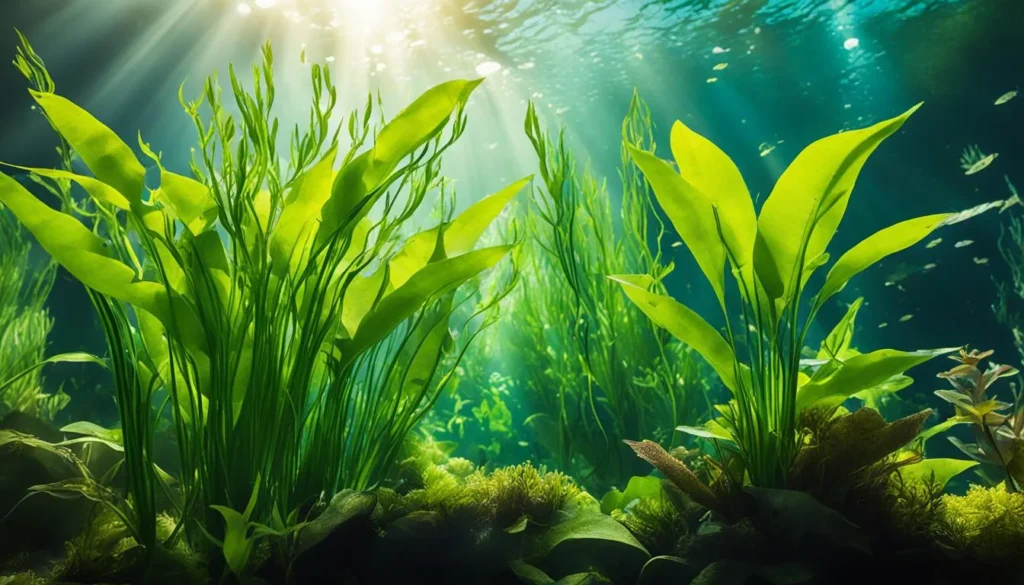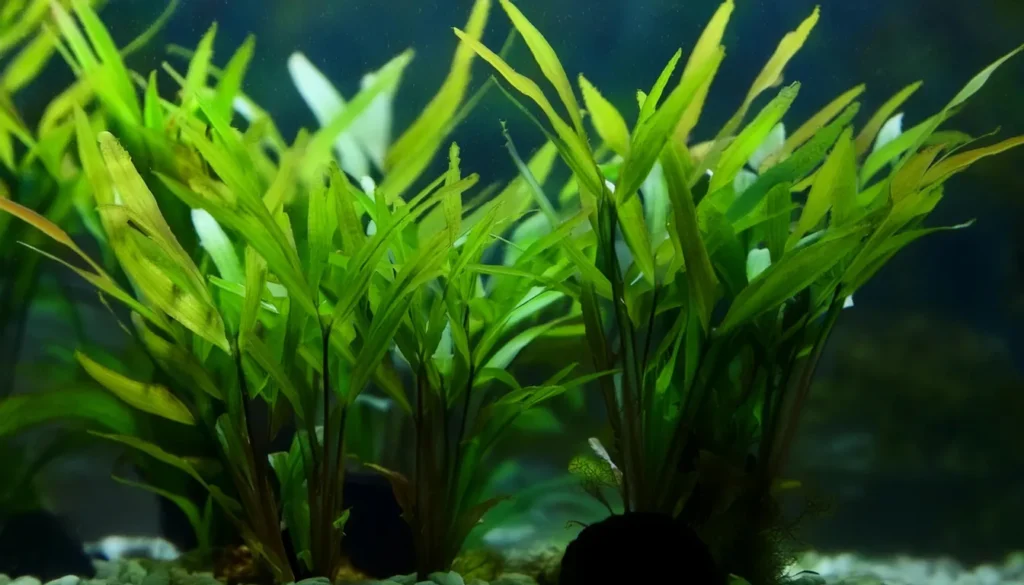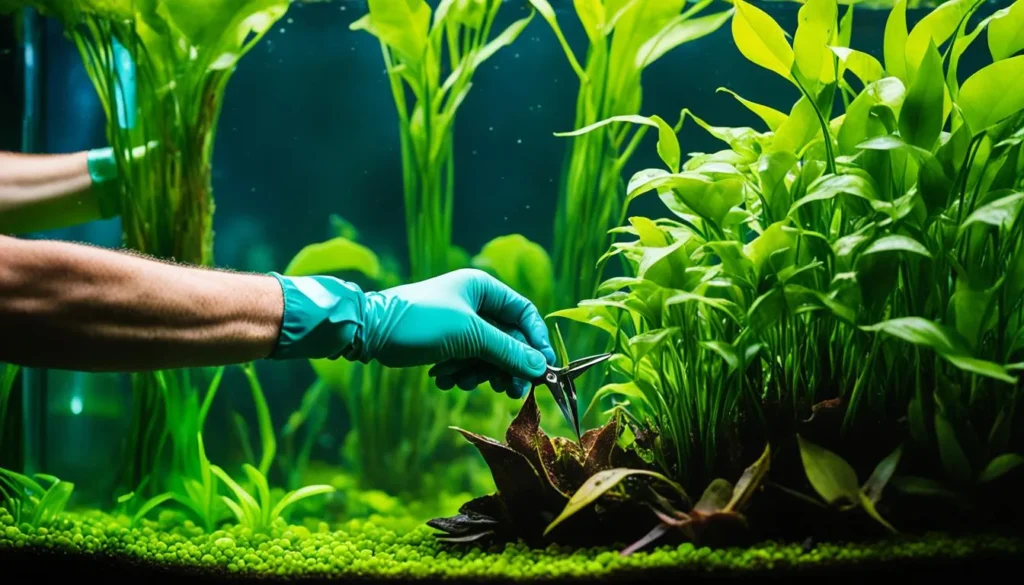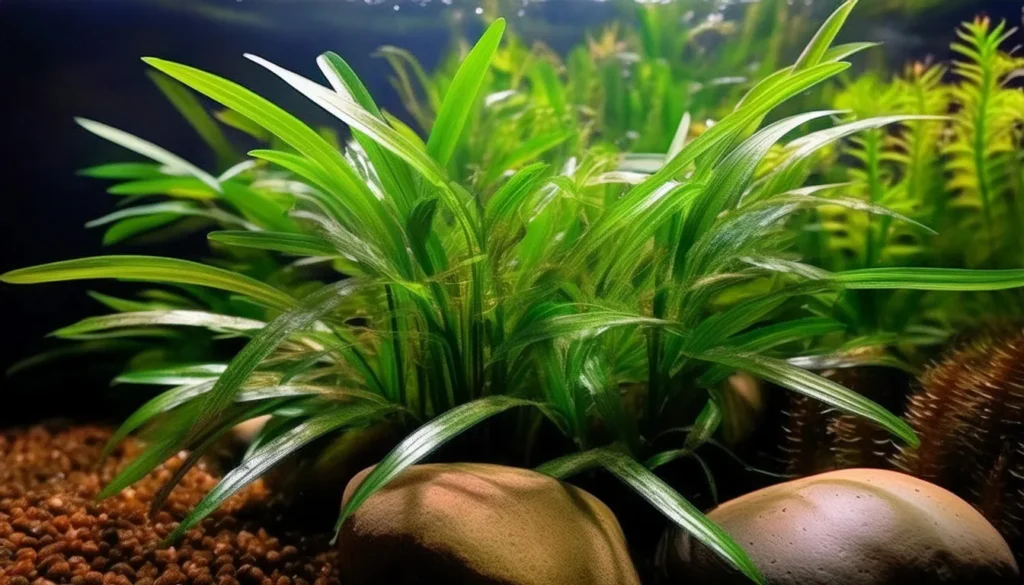Welcome to our comprehensive guide on growing Cryptocoryne lutea, a beautiful aquatic plant that will bring vibrancy and life to your aquarium.
Whether you’re a seasoned aquarist or just starting out, cultivating Cryptocoryne lutea can be a rewarding and relatively simple experience.
With our expert tips and guidance, you’ll soon be able to create stunning aquatic scapes that showcase the beauty of this versatile plant.
Cryptocoryne lutea is highly valued for its attractive appearance and ease of care. Its lush green leaves and hardy nature make it a popular choice for beginner and experienced aquarists.
In this guide, we’ll cover everything you need to know about Cryptocoryne lutea, including its origin, optimal tank conditions, planting techniques, lighting requirements, maintenance, and more.
By following our step-by-step instructions, you’ll be able to cultivate thriving Cryptocoryne lutea specimens that will enhance the beauty of your aquarium.
Let’s dive in and discover how to grow Cryptocoryne lutea for vibrant aquariums.

Key Takeaway
- Cryptocoryne lutea is a versatile aquatic plant highly valued for its attractive appearance.
- Growing Cryptocoryne lutea can be a rewarding experience for both beginner and experienced aquarists.
- With proper care and optimal tank conditions, Cryptocoryne lutea can flourish and bring vibrancy to your aquarium.
- Follow our step-by-step instructions to create stunning aquascapes with Cryptocoryne lutea as the focal point.
- Maintaining regular maintenance and providing necessary nutrition and fertilization is essential for the health of Cryptocoryne lutea.
Quick Stats
| Attribute | Details |
| Family Name | Araceae |
| Origin | Sri Lanka |
| Height | 10-20 cm (4-8 inches) |
| pH Range | 6.0 – 7.5 |
| CO2 Requirement | Low |
| Growth Rate | Moderate |
| Care Level | Easy |
| Color Form | Green, with lanceolate leaves that have a slightly wavy margin |
| Water Conditions | 22-28°C (72-82°F), soft to moderately hard water |
| Max Size | Leaves up to 20 cm (8 inches) long |
| Lighting | Low to Medium |
| Supplements | Benefits from root tabs and liquid fertilizers |
| Placement | Mid-ground |
| Propagation | By runners or splitting the rhizome |
What Is Cryptocoryne Lutea?
Cryptocoryne lutea is a captivating species of aquatic plant that is highly sought after by aquarium enthusiasts. This versatile plant is known for its attractive appearance and ease of care, making it a popular choice for both novice and experienced aquarists.
Origin And Natural Habitat
Cryptocoryne lutea’s origin can be traced back to the tropical regions of Southeast Asia. This plant is native to areas such as Sri Lanka, India, and Myanmar, where it grows in various water bodies, including rivers, streams, and marshes.
Cryptocoryne lutea has adapted to thrive in the submerged conditions of these habitats, developing unique features that make it suitable for life underwater.
Physical Characteristics
- Leaf Shape: The leaves of Cryptocoryne lutea are lanceolate or elliptical in shape, with a pointed tip and a slightly wavy margin.
- Leaf Color: The mature leaves of Cryptocoryne lutea typically display a vibrant green coloration, while new leaves may have a lighter green hue. In some instances, the leaves may exhibit yellowish or bronze tones, especially under certain lighting conditions.
- Leaf Size: The leaves of Cryptocoryne lutea can vary in size, with mature leaves reaching lengths of 10 to 20 centimeters (4 to 8 inches) and widths of 5 to 10 centimeters (2 to 4 inches).
- Leaf Texture: Cryptocoryne lutea leaves have a smooth texture with prominent veins running along the length of the leaf, giving them a ribbed appearance.
- Growth Form: This Cryptocoryne species typically grows in a rosette form, with multiple leaves emerging from a central point or rhizome. It may send out runners to propagate and form new plants.
RELATED: The Aquatic Wonder Bacopa Australis To Transform Your Aquascape
Lighting Requirements For Cryptocoryne Lutea Growth
- Intensity: Aim for a moderate to low light intensity to mimic the shaded environments where Cryptocoryne lutea naturally grows. Avoid using high-intensity lights, as they can lead to algae growth and stress the plant.
- Duration: Provide a photoperiod of approximately 8 to 10 hours per day. This will give Cryptocoryne lutea enough time to photosynthesize and promote healthy growth.
- Spectrum: Use a full-spectrum light with the red and blue wavelengths necessary for plant growth. A light with a color temperature between 6500K and 7500K is suitable for Cryptocoryne lutea.
Temperature Parameters
- Ideal Temperature Range: 22°C to 28°C (72°F to 82°F).
- Stability: Temperature should be kept stable to avoid stressing the plant.
- Tolerance: Can tolerate slightly outside this range but thrives best within it.
- Impact of Fluctuations: Sudden temperature changes can cause issues like melting or stunted growth.
Environment Simulation: This range simulates the plant’s natural habitat in South Asia, promoting healthy growth and vibrant foliage.

Water Parameters For A Thriving Cryptocoryne Lutea
Maintaining optimal water parameters is crucial for the success of your Cryptocoryne lutea in the aquarium. The right pH levels, general hardness (GH), and temperature considerations can significantly impact your plants’ growth and overall health.
pH Levels And General Hardness (GH)
- For Cryptocoryne lutea to thrive, it is important to maintain a pH level between 6.0 and 7.5. These plants prefer slightly acidic to neutral conditions. Additionally, Cryptocoryne lutea prefers a moderate to high general hardness (GH) of 4-8 dGH.
Temperature Considerations
- Cryptocoryne lutea prefers a temperature range of 70-82°F (21-28°C) for healthy growth. It is crucial to maintain a stable temperature within this range to avoid temperature fluctuations, which can stress the plants and inhibit their growth.
Choosing The Right Substrate
- Nutrient-Rich Substrate: Opt for a substrate specifically designed for planted aquariums, such as aqua soil or nutrient-rich planting substrates. These substrates provide essential nutrients for root uptake, promoting healthy growth.
- Fine Grained: Choose a substrate with a fine-grained texture, such as sand or fine gravel. Cryptocoryne lutea has delicate roots that benefit from a soft substrate that allows for easy anchoring and nutrient absorption.
- pH Buffering: Look for substrates that offer pH buffering capabilities to help maintain stable and slightly acidic to neutral pH levels. Cryptocoryne lutea prefers water with a pH range of 6.0 to 7.5.
Placement In The Tank
- Foreground to Midground: Cryptocoryne lutea is typically placed in the foreground to midground areas of the aquarium. Its moderate height and bushy growth make it suitable for creating a lush carpet or adding texture to these areas.
- Spacing: Allow enough space between individual Cryptocoryne lutea plants to accommodate their mature size and growth habit. Proper spacing ensures each plant receives sufficient light and nutrients for optimal growth.
- Grouping: Plant Cryptocoryne lutea in groups or clusters rather than scattering them randomly. Grouping plants together creates a more visually appealing arrangement and allows for easier maintenance.
- Consider Lighting: Place Cryptocoryne lutea in areas of the tank where they will receive moderate to low lighting. Avoid placing them directly under intense lighting, as this can lead to algae growth and stress the plants.
Recommended Tank Size
- Nano Tanks: Suitable for small clusters or individual specimens of Cryptocoryne lutea in nano or small aquarium setups ranging from 5 to 20 gallons.
- Medium Tanks: For larger groupings or midground placement, consider tanks ranging from 20 to 50 gallons. This size provides ample space for multiple plants to establish and grow.
- Large Tanks: In larger aquariums exceeding 50 gallons, Cryptocoryne lutea can be used as a foreground or midground plant, contributing to the overall depth and aesthetics of the aquascape.
Suitable Tank Mates
- Small to Medium-sized Fish: Many community fish species are compatible with Cryptocoryne lutea, such as tetras, rasboras, danios, gouramis, and smaller cichlids like Apistogramma species.
- Shrimp: Dwarf shrimp species like Cherry Shrimp and Amano Shrimp are excellent tank mates for Cryptocoryne lutea. They help clean algae and debris from the leaves and substrate.
- Snails: Some snail species, such as Nerite Snails and Malaysian Trumpet Snails, can coexist peacefully with Cryptocoryne lutea and assist in algae control.
- Bottom Dwellers: Corydoras catfish and small loaches like Dwarf Chain Loaches are suitable tank mates that inhabit the bottom regions of the aquarium without disturbing the plants.
- Peaceful Invertebrates: Consider adding peaceful invertebrates like small freshwater clams or ostracods, which help maintain the tank’s ecosystem balance without posing a threat to Cryptocoryne lutea.

Significance In Aquascaping
- Cryptocoryne lutea is highly significant in aquascaping due to its aesthetic appeal and versatility. Its vibrant green leaves and striking appearance add depth and texture to aquatic landscapes, creating a visually stunning environment.
- Cryptocoryne lutea’s hardiness also makes it an ideal choice for aquascaping projects, as it can withstand a wide range of water conditions and adapt to various lighting levels.
- In addition to its visual appeal, Cryptocoryne lutea plays a functional role in aquascaping by providing shelter and hiding spots for aquatic fauna. The dense foliage of this plant offers a safe haven for small fish and invertebrates, creating a naturalistic and balanced ecosystem within the aquarium.
| Key Features of Cryptocoryne Lutea | Benefits in Aquascaping |
| Attractive green leaves | Enhances the overall aesthetic appeal of the aquarium |
| Hardy and adaptable | Suitable for various water conditions and lighting levels |
| Dense foliage | Provides shelter and hiding spots for aquatic fauna |
Nutrition For Plant
Proper nutrition is crucial for the health and growth of Cryptocoryne lutea, encompassing both macro and micro nutrients essential for its development. Here’s an overview:
Macro Nutrients
- Nitrogen (N): Nitrogen is a vital component of chlorophyll, the pigment responsible for photosynthesis. It’s essential for overall growth and leaf development in Cryptocoryne lutea. Nitrogen is often available in the form of nitrates (NO3-) in the aquarium water or through fertilizers.
- Phosphorus (P): Phosphorus plays a key role in energy transfer processes within the plant, aiding in root development, flowering, and overall growth. It’s crucial for promoting healthy root growth in Cryptocoryne lutea. Phosphorus can be supplemented through phosphates (PO4-) in the water or via fertilizers.
- Potassium (K): Potassium regulates water uptake and osmotic balance in plants, contributing to cell expansion, disease resistance, and overall vigor. Adequate potassium levels are essential for maintaining healthy growth and coloration in Cryptocoryne lutea. Potassium is commonly available in aquarium fertilizers.
Micro Nutrients
- Iron (Fe): Iron is essential for chlorophyll synthesis, enabling Cryptocoryne lutea to carry out photosynthesis effectively. Iron deficiency can lead to yellowing or chlorosis of leaves. Chelated iron supplements are commonly used to provide readily available iron to plants.
- Magnesium (Mg): Magnesium is a component of chlorophyll molecules and is involved in enzyme activation and photosynthesis. It plays a vital role in maintaining healthy green foliage in Cryptocoryne lutea. Magnesium is typically available in aquarium water and can be supplemented if deficient.
- Calcium (Ca) and Sulfur (S): These nutrients are essential for cell wall structure, membrane integrity, and enzyme activation in plants. While calcium and sulfur deficiencies are less common in aquatic plants, ensuring adequate levels through water changes or specialized fertilizers can support overall plant health.
- Trace Elements: Cryptocoryne lutea also requires trace elements such as manganese (Mn), zinc (Zn), copper (Cu), and molybdenum (Mo) in small amounts for various physiological processes. These trace elements are often included in comprehensive aquarium fertilizers to ensure balanced nutrition.
RELATED: Crinum Calamistratum Care Guide & Tips For Beginners
Essentials Of Aquatic Plant Maintenance
- Lighting: Provide appropriate lighting for the specific needs of Cryptocoryne lutea. Ensure the intensity and duration of light are suitable to promote photosynthesis without causing algae issues. LED lights with adjustable settings can be beneficial for controlling light levels.
- Nutrient Supplementation: Regularly fertilize the aquarium to provide essential macro and micro nutrients required by Cryptocoryne lutea. Use liquid fertilizers or root tabs to ensure balanced nutrition. Adjust fertilization based on plant growth and water parameters.
- CO2 Injection (optional): Consider supplementing CO2 in the aquarium if you have high-light setups or densely planted tanks. CO2 injection can enhance plant growth and coloration, but it’s optional for low-tech setups with moderate lighting.
- Water Parameters: Maintain stable water parameters within the optimal range for Cryptocoryne lutea, including temperature, pH, and hardness. Avoid sudden fluctuations in water parameters, as they can stress the plants and lead to health issues.

Daily Maintenance
- Inspect your Cryptocoryne lutea plants for any signs of disease or pests. Remove any affected leaves or plants to prevent the spread of infection.
- Trim any yellowing or decaying leaves using clean scissors or pruning shears. This will promote healthy growth and maintain the overall appearance of your plants.
- Check the water temperature and ensure it remains within the optimal range for Cryptocoryne lutea.
- Observe the water parameters and make necessary adjustments to maintain the ideal conditions for your plants.
- Monitor the lighting intensity and duration to provide the appropriate amount of light for your Cryptocoryne lutea. Adjust if necessary.
- Remove any debris or waste from the aquarium to keep the water clean and prevent the accumulation of harmful substances.
The Role Of CO2 In Plant Health
- CO2 is essential for photosynthesis, the process through which plants convert light energy into chemical energy.
- Cryptocoryne lutea relies on photosynthesis to produce the necessary nutrients and energy for growth. Carbon dioxide, in particular, is a key element used by plants during this process.
- When CO2 levels in the aquarium are insufficient, Cryptocoryne lutea may struggle to absorb and utilize light energy effectively. This can lead to stunted growth, pale foliage, and reduced overall plant health.
- On the other hand, providing adequate CO2 levels promotes robust growth, vibrant colors, and thriving Cryptocoryne lutea plants in your aquarium.

Tips For Propagation
- Identify healthy plant runners: Choose robust plant runners with vibrant green foliage and no signs of damage or disease.
- Prepare the substrate: Before planting the detached plant runners, ensure the substrate is well-prepared. It should be nutrient-rich, with adequate organic matter to support the growth of the new plantlets.
- Detach and plant the plant runners: Gently detach the plant runners from the parent plant, ensuring each plantlet has its own root system. Plant them in the substrate, spacing them adequately to allow room for growth.
- Provide suitable conditions: Maintain optimal tank conditions, including proper lighting, temperature, and water parameters, to promote the healthy development of the new plantlets.
- Monitor and maintain: Regularly monitor the progress of the propagated plantlets. Provide adequate nutrients and water, and ensure they are not overcrowded by trimming or replanting as necessary.
Nutrition And Fertilization
- Proper nutrition and fertilization are vital for promoting the healthy growth of Cryptocoryne lutea in your aquarium. Providing the essential nutrients and supplements ensures that your plants thrive and display vibrant and lush foliage.
- Cryptocoryne lutea requires a balanced diet to fulfill its nutritional needs. Various elements, such as macronutrients (nitrogen, phosphorus, and potassium) and micronutrients (iron, manganese, and calcium), are necessary for optimal growth. Maintaining a consistent and well-rounded nutrient profile will support your plants’ overall health and development.

Dealing With Plant Melting And Decay
- One issue that Cryptocoryne lutea owners may encounter is plant melting and decay. This typically occurs when the plant undergoes a transition period after being introduced to a new environment.
- During this phase, the plant may shed its existing leaves or undergo tissue decay. While it can be alarming, it is natural for the plant to acclimate to its new surroundings.
- To address plant melting and decay, it is important to maintain stable water parameters, including temperature, pH levels, and water hardness. Providing adequate lighting and proper nutrition is also crucial to support the plant’s recovery.
- Additionally, regular water changes and removing any decaying plant matter can help prevent further decay and promote healthy growth.
Conclusion
Throughout this comprehensive guide, we have explored the fascinating world of Cryptocoryne lutea and learned how to cultivate this beautiful aquatic plant for vibrant aquariums.
By following the expert tips and guidelines, you can ensure the successful growth and maintenance of Cryptocoryne lutea in your aquatic environment.
Key points covered in this article include the optimal tank conditions for this plant, such as the ideal water parameters, lighting requirements, and substrate choice.
We have also discussed the significance of CO2 injection, proper nutrition and fertilization, and effective propagation techniques for it.
Additionally, we have addressed common issues that may arise when growing this plant, such as plant melting, decay, algae control, and nutrient deficiencies.
By understanding these challenges and implementing the suggested solutions, you can overcome obstacles and maintain the health and vitality of your Cryptocoryne lutea.
Frequently Asked Question
What Specific Substrate Conditions Are Most Conducive To The Successful Cultivation Of Cryptocoryne Lutea?
This plant thrives in nutrient-rich substrates that provide a good balance of aeration and moisture retention. A substrate composed of a mixture of clay, sand, and organic matter such as peat or decomposed plant material is ideal.
This type of substrate supports the extensive root system of Cryptocoryne Lutea, allowing for efficient nutrient uptake. The addition of root tabs or a slow-release substrate fertilizer can further enhance growth, especially in inert substrates.
The plant prefers a slightly acidic to neutral pH (6.0-7.5) and benefits from a substrate depth of at least 3-4 inches to accommodate its rooting depth.
How Does The Introduction Of Co₂ Supplementation Affect Cryptocoryne Lutea’s Growth And Health?
CO₂ supplementation can significantly enhance the growth rate, color, and overall health of this plant.
While it is not strictly necessary for the survival of the plant, CO₂ supplementation encourages more vigorous growth and can result in larger, more vibrant leaves.
It’s essential to introduce CO₂ gradually and monitor the plant’s response, as sudden changes in CO₂ levels can cause stress. Optimal CO₂ concentration lies in the range of 15-30 ppm.
Consistent CO₂ levels, combined with adequate lighting and nutrient availability, will support lush, healthy growth.
What Are The Ideal Lighting Conditions For Cryptocoryne Lutea, And How Do They Influence Leaf Color And Morphology?
It is adaptable to a range of lighting conditions, from low to medium light levels. It prefers indirect light or moderate artificial lighting, with an ideal intensity of about 20-40 micromoles of PAR.
Under low light, the plant will produce larger, thinner leaves, while brighter light conditions tend to result in smaller, thicker leaves with more intense green coloration.
Excessive light can cause the leaves to become pale or lead to algae growth on the leaves, so it’s important to find a balance that supports healthy growth without inducing stress.
Can Cryptocoryne Lutea Be Used In Aquascaping, And What Are Some Effective Design Tips For Incorporating It Into Aquarium Layouts?
It is an excellent plant for aquascaping due to its moderate size, attractive foliage, and ease of care. It works well as a mid-ground plant in larger aquariums or a background plant in smaller setups.
For a natural-looking aquascape, group Cryptocoryne Lutea in odd numbers, allowing enough space for each plant to spread and form dense clusters. Its rich green color contrasts beautifully with darker substrates or rocks, and its leaf texture complements smoother plants and hard scapes.
Regular pruning will encourage bushier growth and prevent the plant from overshadowing smaller species.
What Are Common Challenges In Growing Cryptocoryne Lutea, And How Can Aquarists Address Them To Ensure Healthy Development?
One common challenge with this plant is the “melting” phenomenon, where leaves disintegrate as the plant adjusts to new conditions. This is normal and usually occurs when the plant experiences significant changes in water parameters or lighting.
To minimize stress, acclimate the plant slowly to its new environment, and maintain stable conditions. Another issue can be nutrient deficiencies, manifested as slow growth or discolored leaves.
Addressing this involves ensuring a nutrient-rich substrate and possibly supplementing with liquid fertilizers.
Lastly, It can sometimes be susceptible to crypt rot, a condition prevented by avoiding damage to the roots and base of the plant during planting and maintenance.
- Unveiling The Wonders Of Riccia Fluitans In Aquascapes - August 7, 2024
- Vallisneria Gigantea Var. Guide To Care And Cultivation At Home - July 31, 2024
- Vesicularia Dubyana Care & Growth Guide Tips For Beginner Gardeners - July 30, 2024
